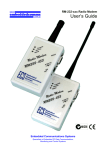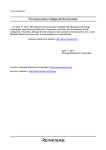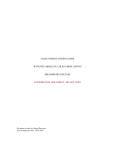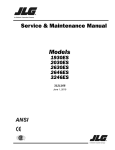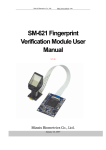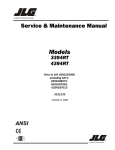Download User's Guide - Embedded Communications Systems
Transcript
TCM2-4DIO Telemetry Control Module User’s Guide Embedded Communications Systems Specialists in Embedded RF Data Communications, Monitoring and Control Systems Copyright Notice Copyright ©2002-2003 by Embedded Communications Systems Pty Ltd. All rights reserved. Under the copyright laws, this manual cannot be reproduced in any form without the prior written permission of Embedded Communications Systems. No patent liability is assumed, with respect to the use of the information contained herein. embeddedcomms TCM2-4DIOTelemetry Control Module User’s Guide Fourth Edition April 2004 (Covers firmware version 2.00a. Hardware 320-6+) Disclaimer This manual has been validated and reviewed for accuracy. The instructions and descriptions it contains are accurate for the embeddedcomms TCM2-4DIO-433 Telemetry Control Module at the time of this manuals publication. However succeeding products and manuals are subject to change without notice. Embedded Communications Systems assumes no liability for damages incurred directly or indirectly from errors, omissions or discrepancies between the TCM2-4DIO controller and the manual. These radio devices may be subject to radio interference and may not function as intended if interference is present. Systems should be designed to tolerate such interference. RF transmission power levels are subject to regulatory approval in countries: consequently, it is possible that some radio interface functionality is not provided in your country. This will be detailed in this manual if applicable. Radio and EMC Regulations The user of the TCM2-4DIO Telemetry Control Module must satisfy all relevant EMC and other regulations applicable in the intended country of use. The radio modules used in the TCM2-4DIO Telemetry Control Modules are type approved to EN 300 220-3 and EMC conformant to EN 301 493-3. Problem Reporting and Feedback To report operational problems, documentation problems, suggested product enhancements or obtain technical assistance please email technical support at [email protected]. Please include in all email correspondence your name, company, controller type, module serial number and firmware version. All information supplied to Embedded Communications Systems will be treated in the strictest of confidence. User’s Guide Page ii About this Manual How To Use This Manual In order to obtain the maximum benefit from your TCM2-4DIO product, it is recommended that you read at least the introduction chapter and the installation & operation chapter. Warnings 1. Incorrect termination of the supply lines may result in internal damage to your TCM2-4DIO module and will void your warranty. To avoid any such issues please double check all wiring prior to applying power to the module. 2. It is strongly recommended that each TCM2-4DIO module be checked operationally on the work bench prior to being wired into the final application. 3. To avoid potential accidents during installation and maintenance of remote controlled equipment, all equipment should be disconnected and electrically isolated from the TCM2-4DIO module. 4. All equipment connected to the TCM2-4DIO module should be clearly labelled with a warning indicating that the equipment is subject to automatic operation and may start without warning. 5. The TCM2-4DIO is not suitable for use in explosive environments or for life critical applications. 6. The TCM2-4DIO power regulation and battery charging circuit can become relatively hot during operation. This is normal and as a result good ventilation should be provided around the power regulation components on the module. Also contact with the power supply components should be avoided. Package Contents The TCM2-4DIO IO Control module is supplied only as an OEM PCB. A serial D9 extension cable is required for connection to a serial terminal program for configuration. Printed manuals are not supplied with the IO Controller. Instead the manual is supplied in electronic form with you order. Antennas are not provided with the TCM2-4DIO Controller module. Please contact your supplier for a selection of antennas to use. User’s Guide Page iii Contents: Chapter 1 Introduction ......................................................................................... 2-1 General .................................................................................................................2-1 The TCM2 – Telemetry Control Module .....................................................................2-1 Features................................................................................................................2-1 Applications...........................................................................................................2-1 Chapter 2 Installation........................................................................................... 2-1 General .................................................................................................................2-1 TCM2 Interface Connections ....................................................................................2-1 Enclosure ..............................................................................................................2-2 RS232 Serial Port ...................................................................................................2-2 Power Supply.........................................................................................................2-2 AC Supply..............................................................................................................2-3 DC Supply .............................................................................................................2-3 Battery Supply .......................................................................................................2-3 Digital Inputs.........................................................................................................2-3 Digital Outputs.......................................................................................................2-4 Indicator LEDs .......................................................................................................2-4 Fail Safe Operation .................................................................................................2-5 Current Consumption..............................................................................................2-6 Chapter 3 Operation ............................................................................................. 3-1 Power Failure – System Power Fault.........................................................................3-1 Event Reporting .....................................................................................................3-1 Chapter 4 TCM2 Configuration ............................................................................. 4-1 General .................................................................................................................4-1 The Serial Interface ................................................................................................4-1 Entering the Configurator........................................................................................4-2 Password Protection ...............................................................................................4-2 Data Encryption .....................................................................................................4-2 Addressing Scheme ................................................................................................4-2 Port Numbering......................................................................................................4-3 Types of Configuration Settings ...............................................................................4-3 Default User Options ..............................................................................................4-4 Default Port Mapping ..............................................................................................4-4 User’s Guide Introduction iv Default Port Settings...............................................................................................4-5 General Commands in Detail....................................................................................4-6 User Option Commands ..........................................................................................4-7 Port Mapping Command..........................................................................................4-9 Port Setting Command..........................................................................................4-10 Chapter 5 Product Version Information ............................................................. 5-14 Version Information..............................................................................................5-14 Firmware Version Numbering Scheme.....................................................................5-14 Chapter 6 Modification History........................................................................... 6-15 Hardware ............................................................................................................6-15 Firmware.............................................................................................................6-15 User’s Guide Introduction v Chapter 1 Introduction General This manual covers the TCM2-4DIO-xxx range of low cost short range telemetry control modules. These modules have been specifically designed to operate in the international license exempt ISM radio band. The modules currently covered by this manual include the following: TCM2-4DIO-151P UHF Control Module – Centre frequency: 151.300MHz @ 100mW TCM2-4DIO-173P UHF Control Module – Centre frequency: 173.225MHz @ 100mW TCM2-4DIO-433 UHF Control Module – Centre frequency: 433.920MHz @ 10mW TCM2-4DIO-869 UHF Control Module – Centre frequency: 869.850MHz @ 1mW TCM2-4DIO-914 UHF Control Module – Centre frequency: 914.500MHz @ 0.75mW The acronym TCM2 will be used as a generic reference throughout this manual when referring to anyone of the Telemetry Control Module variants mentioned above. Any detail relating specifically to a particular model will be noted by reference to the full module name. The TCM2 – Telemetry Control Module The TCM2-4DIO Telemetry Control module is a fully configurable 4 channel digital IO controller used for relaying digital I/O signals over long distances without the need for a wired connection. Features Following are a list of the features offered by the TCM2. • • • • • • • 4 x Opto-isolated inputs 4 x Relay outputs (4x NO) 1 x Link Failure Relay Output Individual port mappings Built-in serial configuration Password protected configuration Battery backup support and charger Applications The applications of the TCM2 are many and varied in all areas of control and monitoring. Following are a list of some of the applications: • • • • • User’s Guide Remote pump control Mining equipment control Water and sewage equipment Building management and control Agricultural and irrigation systems Introduction 2-1 Chapter 2 Installation General Prior to installing a new system of networked TCM2’s in the field, it is strongly recommended to bench test the entire system. Configuring and fault finding a system of TCM2’s is easier when all devices are close together and accessible. After installation of a new system or system unit, most problems are caused by poor radio communications. This can be the result of an incorrectly installed antenna, interference on the radio channel or an inadequate radio path. Assuming the radio path is at fault due to long path lengths or obstructions in the lineof-sight, then higher performance antennas or a more elevated mounting point for the antenna may fix the problem. Each TCM2 should be adequately earthed using a ground terminal (GND) on the TCM2. This will ensure effective and reliable operation of surge protection circuits in the TCM2. TCM2 Interface Connections The diagram below shows the connections, as described in the following sub-sections, available on the TCM2. User’s Guide Operation 2-1 Enclosure The TCM2 is supplied without an enclosure. This has a two fold effect, it keeps the module cost lower and reduces the overall size of the TCM2 when installing along with other equipment in an equipment enclosure. The TCM2 can be mounted using the M4 mounting holes provided around the circuit board. Ensure that the rear of the circuit board does not come into contact with any metal surfaces or protruding objects. The TCM2 is compatible with the 107mm DIN rail PCB holders. It is therefore suitable for DIN rail mounting in equipment rack, or enclosures equipped with a length of standard DIN rail tracking. RS232 Serial Port The serial port is a standard 9 pin female D9 style connector providing a 3 wire RS232 interface to a connected serial device. The serial port is wired as a DCE device and used to connect to a terminal or PC for configuration and field testing. The serial protocol, by default, is set at 9600 baud, 8 data, one stop bit and no parity. TCM2. D9 Male RXD TXD GND 2 3 5 PC. D9 Female 1 2 3 4 5 6 7 8 9 DCD RXD TXD DSR GND DTR CTS RTS RI Power Supply The TCM2 is powered through a linear regulator and can accept either AC or DC voltages. It is recommended that the TCM2 be mounted in a manner that provides good ventilation and airflow as the regulator can generate heat during normal operation. The TCM2 also provides connection for battery power. The battery inputs can be used either as a backup battery input, or as a main power source. A battery charging circuit is designed into the TCM2 that enables battery backup of the unit in the event of failure with the main power source. Following are the acceptable operating input voltage limits for the TCM2: Supply Inputs : 12 to 16 volts AC RMS or 17 to 21 volts DC Battery Input: 11 to 14 volts DC. User’s Guide Operation 2-2 AC Supply The AC supply is connected to P1 and P2 terminals. The AC supply should be floating relative to earth. The following diagram details connection of the AC supply with a backup battery (optional). 2A Fuse AC Supply 12 – 16VAC ~ P1 B+ Backup Battery if required. TCM P2 GND Note: A 16VAC/1A mains plug pack is available from your supplier. DC Supply A DC supply can be connected to terminals P1 and P2. The DC supply should be floating relative to earth. The following diagram details connection of the DC supply along with a backup battery (optional). 2A Fuse DC Supply 18 – 21VDC + P1 B+ Backup Battery if required. TCM - P2 GND Battery Supply The TCM2 may be powered by an external battery connected to the battery terminal B+ and B-. Ensure correct polarity is observed to prevent damage to the TCM2. 2A Fuse B+ TCM GND 12 Volt Backup Battery. Digital Inputs The TCM2 modules are provided with four fully protected opto-isolated digital inputs with an isolation rating of 5000 volts. The inputs are compatible with voltage free contacts such as relays and other mechanical switches or NPN transistor devices. They are however not suitable for PNP transistor type switching devices. A contact wetting current of approximately 5mA is provided to ensure reliable operation of driving devices. The resistance of the switching device must be less than 200 ohms to guarantee activation of the digital input. The digital input state is indicated by a red LED that is lit when the input contact is closed. User’s Guide Operation 2-3 Connection of the digital input is between Dix (DI1 to DI4) and GND (ground). This is indicated in the following diagram. DIx NPN Transistor Drive Input Digital Input GND TCM-DIO-xxx DIx Voltage Free Contact Input Digital Input GND Digital Outputs The TCM2 modules provide five voltage free relay contacts. Four relay contacts are normally open and one relay contact a normally closed contact for the fail safe link fail condition. The relay contacts have the following ratings. AC Resistive Load 1A /125VAC DC Resistive Load 0.5A/30VDC Further information on the relay contact rating can be found on the relay datasheet provided at www.embeddedcomms.com. The TCM2 can be provided with higher specification switching relays upto 3A. Please enquire if you require this option. DOx Digital Output RLY AC Load TCM-DIO-xxx 1N4004 DOx Digital Output RLY Supply DC Load GND Indicator LEDs The TCM2 provides a visual indication of its current input, output and internal state by way of 14 LEDs in various colours. User’s Guide Operation 2-4 The state of each digital input is indicated by way of a RED LED. The LED is lit when the input is active, in other words the input contact is closed. Likewise with the digital outputs, the LED is lit when the output relay is activated and its contacts are closed. There are three status indicator LEDs which display the current internal state of the TCM2. These LEDs are labelled on the TCM2 circuit board as OK, PWR and SYS. The following table details the meaning of these LEDs. Name State OK GREEN ON Normal operation. Indicates the state of power to the input and output circuits. OFF Fault or in configuration mode. A fault condition will cause power to IO circuitry to be shutdown. ON Normal operation Indicates that the supply voltage is present. OFF Fault No supply voltage is present, thus the controller will not operate. ON In Configurator If in the configurator this LED is lit permanently. OFF Fault Controller is not functioning. Normal operation A short pulse indicates the controller is operating normally. PWR RED SYS BLUE Pulsing ON Condition Meaning The radio controller interface contains two indicator LEDs to show the state of the radio. These LEDs are both RED and are labelled TXD and RXD. The receive indicator LED lights red when the radio is receiving data. The transmit indicator lights red when the radio is transmitting a data packet. Fail Safe Operation The TCM2 provides a two level fail-safe mechanism in the event of a fault condition causing a module failure. Should the processor firmware fail for any reason an onboard timer circuit will ensure the processor is reset and held in a reset state until the fault is removed. A pending hardware fault condition, such as a lower power state, will reset a hardware timer which will cause all power to be removed from the input and output circuits. Thus the outputs will be reset into a known safe state that being all normally open relay contacts being opened and the normally closed relay contacts being closed. A low power state will occur when the input voltage (after regulation if using an external AC/DC supply) drops below 11.0V. This will cause the outputs to be reset into their default state. During this state all communications to and from the TCM2 will be regarded as a communications failure. Thus no replies will be sent nor will any input state changes or polling requests be sent. User’s Guide Operation 2-5 During normal operation, once a link is established with a remote controller the link fail relay contacts will be opened. If the communications link for some reason is lost the link fail relay will close its contacts. The static state of these contacts is closed, thus the output can be used as a fail safe mechanism. Current Consumption The following table details the current consumption of the TCM2 module. Operating State Average current consumption Standby 60mA Input closed 15mA per input Output closed 25mA per output The following are two examples of calculating the total current consumption. 1. All inputs closed; output open Standby + Input * 4 60mA + 15mA * 4 = 120mA 2. All output closed; inputs open Standby + Input * 4 + output * 5 60mA + 25mA * 5 = 185mA 3. All inputs closed; all outputs closed Standby + Input * 4 + output * 5 60mA + 15mA * 4 + 25mA * 5 = 245mA User’s Guide Operation 2-6 Chapter 3 Operation Power Failure – System Power Fault The TCM2 is designed to continuously monitor the regulated power supply which drives the internal switching and control circuitry. During normal operation the supply voltage should sit at approximately 13.8 volts when running off the external AC/DC supply. This could be less when running from a battery depending on whether or not the battery is being float charged or partially discharged. The recommended end of discharge voltage for Sealed Led Acid (SLA) batteries is given at 1.75V per cell, thus for a 12V six cell SLA battery this works out at 10.5 volts. Should the internal regulated supply voltage of the TCM2 drop below 11.50 volts, the controller will shut down power to the input and output circuits, thus effectively shutting down the outputs into a safe state. The controller will stay in a nonoperative shut down state until the supply voltage recovers to over 12.0 volts. Powering down into a safe state not only saves possible damage to the battery through excessive discharge but also guarantees the minimum switching voltage of the TCM2 output relays is not exceeded, thus preventing the problem of unreliable and intermittent operation of the relays. If using a serial terminal, the command STATUS can be used to verify that the cause of the problem was a ‘SYSTEM POWER FAULT’. The number of times the voltage has dropped below the shut down point is also displayed. Note this count value will be reset to zero by resetting the TCM2. Normal operation of the TCM2 will resume once the internal regulated voltage recovers to above 12.0 volts. This allows the TCM2 to recover if it were operating from say a solar power system where for some reason the battery voltage drops overnight. In any event, when a system power fault is noticed the cause of the problem should be determined and measures put in place to ensure it does not occur again. A ‘SYSTEM POWER FAULT’ will cause the OK LED to be extinguished. The LED will stay off until the TCM2 power is restored to a non fault state. The current internal regulated voltage can be checked by stopping the controller (STOP) and issuing the BATT command. The BATT command will display the current voltage continuously 4 times a second until a key is pressed. Event Reporting The TCM2 is capable of reporting events to the serial port for the purpose of event logging. Main system events that are reported, when reporting is enabled, are input and output state changes, battery fail events and communications failures. Following details the format of the messages: Digital Inputs <uXX:diY=Z> User’s Guide eg: <u01:di1=O> TCM2 Configuration 3-1 where: XX is the unit number, Y is the input number Z is ‘O’ for input open or ‘C’ for input closed. Digital Outputs <uXX:doY=Z> eg: <u01:di1=O> where: XX is the unit number, Y is the output number, Z is ‘O’ for relay open or ‘C’ for relay closed. Battery Failure <uXX:pwr_fault=YV> eg: <u01:pwr_fault=10.90V> where: XX is the unit number, Y is the sensed battery voltage. Communications Failure <uXX:diY=CF> eg: <u01:di1=CF> where: XX is the unit number, Y is the input or output number, CF stands for communications failure. User’s Guide TCM2 Configuration 3-2 Chapter 4 TCM2 Configuration General Configuring the TCM2 is relatively straightforward and easy. The following chapter provides details on using and connecting to the serial configurator. It also describes in detail the configuration commands available to the user and their meaning. The Serial Interface The TCM2 is configured using a terminal device via the serial port, thus no expensive complicated configuration software is required. The serial port of the TCM2 complies with RS232 voltages and uses a 3 wire interface to communicate. These being transmit data (TXD), receive data (RXD) and ground (GND). D9 Male (DCE) TCM2 PC 1 - NC 2 - TXD 3 - RXD 4 - NC 5 - GND 6 - NC 7 - NC 8 - NC 9 - NC 1 2 - TXD 3 - RXD 4 5 - GND 6 7 8 9 D9 Female (DTE) Basic 3 wire Serial Interface from a TCM2 to a PC The terminal device used to configure the TCM2 can be anything from a basic dumb serial terminal, a PC running HyperTerminal or other communications software, or a handheld PDA. Anything that has an RS232 serial port and can act as a text based terminal program can be used. The serial port on the TCM2 is configured as a DCE interface. The serial protocol settings are 8 data bits, 1 stop bit and no parity. Simply use the enclosed serial cable to connect your TCM2 to a serial port on a PC or laptop, launch your favourite terminal program – you’re now ready to configure the TCM2. Applying power to your TCM2 at this stage should result in a sign on message being sent by the TCM2. If the TCM2 is already power up, then press enter to see the command prompt. -----------------------Telemetry Control Module Model: TCM2-4DIO-433 Freq: 433.920 MHz SNo: 00123 F/w V2.00a ........................ > Typical signon message at powerup User’s Guide TCM2 Configuration 4-1 Note: Ensure hardware flow control is disabled in your terminal program. Entering the Configurator Upon powering up, the TCM2 module configures itself before running its internal control and monitoring program. The TCM2 must therefore be stopped before the configurator can be entered in order to change operating parameters. Typing stop at the command prompt will cause the internal control and monitoring program to stop and enter the configurator. If however password protection is enabled, then the password must be entered, using the pwd command, prior to attempting to stop the control and monitoring program. Password Protection The TCM2 allows password protection over the configuration settings to be set, thus ensuring only authorised personnel can either stop the TCM2 and/or change its configuration. As default, password protection is not enabled when the TCM2 is shipped from the factory. Thus a password is not required to be entered to stop and change the configuration. It is strongly advised that a password is set prior to installing the TCM2 in the field. Note, that the password must be the same across all installed units as the password is used to directly encrypt the data transmitted over the radio. Note, the password can be a maximum of 8 characters and can contain both numbers and letters. All characters entered into the TCM2 are converted to lower case before processing, so using upper case characters has no effect. Thus the password can be entered as upper or lower case. Once the password is set within the configurator, the password cannot be viewed. So ensure you test the password before exiting the configurator, to ensure you have got it right. While in the configurator the password can be cleared, however once the TCM2 is reset and running, its not possible to bypass a forgotten password to enter the configurator to subsequently clear it! WARNING: Ensure you record and keep the password in a safe place to prevent unauthorised tampering with the TCM2 configuration. Data Encryption By default the TCM2 does not employ data encryption to transmitted data. Having the TCM2 configured with a password enables encryption of the transmitted data over the radio. Setting the password not only protects the TCM2 from unauthorised access it is also used as the key to encrypt the transmitted data. All units within a site that are expected to communicate with each other should be configured with same password. Addressing Scheme Each IO Controller is configured with a site address and a unique unit address. The site address is common to all IO Controllers working within a particular system, and prevents cross communications with other IO Controllers in different systems. User’s Guide TCM2 Configuration 4-2 Multiple systems may operate within close proximity without affecting each other. The IO Controller supports up to 254 different site addresses. Each IO Controller working within a system must have a unique unit address. A system of IO Controllers can support up to 254 unique units in any one site. A unit address of zero is reserved for system wide broadcast messages within a site. Port Numbering Input ports on the TCM2 have the following number scheme: D - Digital I - Input n - Port number 1 to 4 Output ports on the TCM2 have the following number scheme: D - Digital O - Output n - Port number 1 to 4 Types of Configuration Settings The TCM2 has three types of configurable settings. They are as follows: • User Options – Basic interface and operating settings • Port Mapping – Port mapping settings • Port Settings – Port control settings Default settings for these configuration categories are covered in the following sections. Later in this chapter the actual configuration commands are presented in detail. User’s Guide TCM2 Configuration 4-3 Default User Options The TCM2 has a number of user options that control the operating interface and TCM2 addressing. Following table details the default user options for the TCM2: User Option Serial port baud rate Default Setting 9600 baud TCM2 unit address 1 TCM2 site address 1 Password/Encryption none Event reporting off Default Port Mapping Factory default port mapping is set such that all inputs on TCM2 A are mapped directly to the corresponding outputs of TCM2 B. And all inputs on TCM2 B are mapped to the corresponding outputs on TCM2 A. The following diagram details the default mapping. TCM2 A DI1 DO1 DI2 DO2 DI3 DO3 DI4 DO4 DO1 DI1 DO2 DI2 DO3 DI3 DO4 DI4 TCM2 B Default Port Mapping Use the ‘map clear’ command sequence to reset the port mapping back to the default as shown above. Using ‘map clear’ not only resets the port mapping to a one to one scheme but also sets the destination (map to) address as either the one above the current unit (if the local unit address is odd) or one below (if the local unit address is even). See the map command in the configuration chapter for more information. User’s Guide TCM2 Configuration 4-4 Default port mapping does not set or reset any action on Communications Failure or battery low condition. Instead use the port command to set default IO port parameters. Default Port Settings The TCM2 has a number of settings that can be applied to individual input and output ports. Following table details the default user options for the TCM2: Input Port Setting Command Default Setting Enable/Disable port <id> [enable|disable] Enabled Invert port <id> invert [on|off] Off Debounce time port <id> dbnce [n] 0.5 seconds = 50 (x10ms) Update period port <id> updper [n] 30 seconds (0.5 mins) = 300 (x100ms) Rate of change port <id> change [n] 2 seconds = 20 (x100ms) Halt on CommsFail port <id> cfhalt [on|off] Output Port Setting Default Setting Enable/Disable Enabled Update period 300 seconds (0.5 mins) Halt on CommsFail Off Reset port on CommsFail Off Reset delay after CommsFail 0 seconds Off These port settings can be change by using the port command in the configurator. For more information please refer to the port command in the configuration section. User’s Guide TCM2 Configuration 4-5 General Commands in Detail help Display basic help information This command is used to display brief help information. For detailed help information the manual should always be consulted! stop Stop the controller and enter the configurator Entering this command will effectively stop the IO controller from sending updates and responding to received remote requests. After stopping the IO controller the user is passed into the configurator allowing the user to then change the operating configuration. Note: all outputs are reset back to their initial off state once the IO controller is stopped. reset Exit the configurator and restart the controller This command exits the configurator and restarts the TCM2. After the reset the updated settings will take immediate effect. restart Restart all local IO Controller on same site addrss This command exits the configurator and restarts the TCM2. As part of the restart sequence it broadcasts a reset to all modules using the current site number. This has the effect of re-synchronising the network especially if port mappings have changed. serial Display the unit serial number This command displays the serial number. User’s Guide TCM2 Configuration 4-6 User Option Commands baud Serial interface baud rate This command sets the host interface (DTE) baud rate. The updated DTE baud rate will take effect after leaving the configurator and restarting the TCM2 using the reset command. Command format baud [n] where: n = 600, 1200, 2400, 4800, 9600, 14400 19200, 38400, 57600, 115200 unit Set TCM2 unit address This command sets the device unit address. Each TCM2 must be set with a unique unit address that is not identical to any other unit on the network. This unit address is used when mapping input ports to the output ports of a remote TCM2. The unit address is combined with the site address to allow distinct groups of TCM2 modules to be used within close proximity of each other without interference. Command format: unit [n] where: n = [1-255] site TCM2 unit address. Set TCM2 network site address This command sets the device site code. Each site code can effectively support up to 255 different unit addresses. Command format: site [n] where: n = [1-255] pwd TCM2 site code. Used to enter a password If password access is enabled, this command is used to enter a password prior to stopping the IO controller and entering the configurator. Due to security reasons it’s not possible to reset a forgotten password thus it’s important to record the password once set. The TCM2 cannot be stopped, and hence the configurator cannot be entered unless a valid password is given. Command format: pwd [<s>] where: s = User’s Guide TCM2 Configuration 4-7 [a-z:0-9] The password can be up to 6 characters and consist of the characters ‘a’ thru ‘z’ and the numbers ‘0’ thru ‘9’. setpwd Set password This command can only be used from within the configurator, hence the TCM2 must be stopped. The command is used to both clear and set the password. Command format: setpwd [clear|<s>] where: s = [a-z:0-9] The password can be up to 6 characters and consist of the characters ‘a’ thru ‘z’ and the numbers ‘0’ thru ‘9’. The password will be saved and is then subsequently required to enter the configurator. clear report This is used to erase the password. By clearing the password the TCM2 can be stopped and changes made to the configuration without requiring to enter a password. Enable event reporting to the serial port This command can only be used from within the configurator, hence the TCM2 must be stopped. The command is used to enable event reporting to the serial port of port change, communications failure and battery fault events. Refer to a description of event reporting in Chapter 3. Command format: report [n] where: n = User’s Guide on Enables event information to be sent to the serial port. off Disables event reporting. TCM2 Configuration 4-8 Port Mapping Command map Map inputs to remote outputs This command is used to define the mapping of local input ports to output ports on a remote TCM2. A number of options can be specified with this command. Using the command by itself will result in the port mappings being displayed. Clearing the Port Mappings The port mapping can be cleared back to a one-to-one scheme by using this command. This is very useful in order to reset the port mapping back to a known state. In addition to resetting the destination port an input is mapped to, it also resets the destination unit address to which a port is mapped. The destination unit address is reset to a value either one higher than the local unit address (if the local unit address is odd) or one lower than the local unit address (if the local unit address is even). This is a very useful command if you are setting up a new TCM2 pair on new unit addresses. Thus for instance, if the local unit address is set to 10, performing a map clear would result in all input ports being mapped to output ports on destination unit 9. On the destination unit, if the local unit address is set to 9, then performing a map clear will result in all input ports being mapped to output ports on unit 10. Command format: map clear Clears the port mapping. Setting the Port Mappings Port mappings from a local input port, to a remote output port are accomplished using the map command as follows: Command format: map <input> to <output> on < unit address> where: input = di1,di2,di3,di4 Input port and: output = do1,do2,do3,do4 Output port and: unit address = 1 to 255 Remote unit address to which the port is being mapped. Example command format: map di1 to do4 on 5 User’s Guide This will map the input port DI1 to the output port DO4 on remote unit number 5. TCM2 Configuration 4-9 Port Setting Command port Configure input and output ports This command is used to configure individual local input and output ports of the TCM2. Listing all port settings The port command can be used alone with no parameters to list the settings of all input and output ports. Command format: port List all input and output port settings Listing all input or output port settings The port command can be used to list the settings of only the input or only the output ports. Command format: port input List all input port settings port output List all output port settings List settings for a specific port The port command can be used to list the settings of a nominated port by specifying the port id. Command format: port <port id> where: port id = di1, di2, di3, di4 or do1, do2, do3, do4 the specified port Lists the port settings of Clearing all port settings All input and output port settings can be reset to factory defaults by using the clear argument. This affects all ports at once. Command format: port clear Clear port settings back to factory defaults. Input port settings The following list of commands is valid for input ports. Their function and purpose is described. enable Enable the port for operation An input port that is enabled will respond to input state changes and send the state change information to the port it is mapped to. Command format: User’s Guide TCM2 Configuration 4-10 port <port id> enable disable Enable the port for operation Disable the port operation An input port that is disabled from operation will not respond to changes in the input state. Command format: port <port id> enable invert Enable the port for operation Invert the state of the input The logic state of the input port is inverted. Command format: port <port id> invert [on|off] the input state dbnce Enable or disable the inversion f Set the input port debounce time The input debounce time can be set in order to prevent false triggering due to noise, power spikes and other potential interference. Command format: port <port id> dbnce [1-255] Set the debounce time from 10ms (1 x 10ms) to 2.55secs (255 x 10ms). updper Set the port update period This command sets the update period for the given input port. If a state change has not occurred on the given input port for the period of time specified by this parameter, then an update will automatically be sent to the remote output port that this input is mapped to. Command format: port <port id> updper [100-60000] Set the update period from 10sec (100 x 100ms) to 100min (60,000 x 100ms). change Set the rate of change This sets the rate of change that can be fed to this input. Thus a new change of state on the given input is not recognised until after the change period. Command format: port <port id> change [1-255] Set the rate of change time from 10ms (1 x 10ms) to 2.55secs (255 x 10ms). retry Set the number of transmission retries Upon a state change on an input a message is sent to the remote mapped port. If for some reason the remote port does not respond within a random time period, the transmission will be attempted again. The retransmissions will continue for the number of retries. Should the number of retransmissions exceed the set number, the port is considered to be in a communications failure state. User’s Guide TCM2 Configuration 4-11 Command format: port <port id> retry [1-10] reties. cfhalt Set the number of transmission Set the action upon comms failure Should the input port be unable to communicate a port state to the remote unit after the set number of retries, the port then has two options. The first is to carry on trying to communicate its state to the remote device at the update period rate. The other option is to halt the port and thus prevent it from trying to send its state to the remote device. Halting the port will require a manually intervened reset of the device to get it running again. A reset can be either a power cycle, or using the serial configurator to stop and reset the controller. Command format: port <port id> cfhalt [on|off] Select halt on comms fail. Output port settings The following list of commands is valid for output ports. Their function and purpose is described. enable Enable the output port for operation Should the output port be disabled, any received state update for this port shall be ignored. Command format: port <port id> [enable|disable] updper Enable/disable the output port. Set the update period This sets the update period for receiving state changes. Should the update period be reached without communications from the remote input port, the controller will request an update from the remote input port by way of a polling request. Command format: port <port id> updper [100-60000] Set the update period from 10sec (100 x 100ms) to 100min (60,000 x 100ms). retry Set the number of transmission retries Should an output port update period be exceeded then the controller will poll the remote input port for a state update. If for some reason the remote input port does not respond within a random time period, the poll request will be attempted again. The retransmission of the polling request will continue for the number of retries. Should the number of retransmissions exceed the set number, the port is considered to be in a communications failure state. Command format: port <port id> retry [1-10] reties. User’s Guide Set the number of transmission TCM2 Configuration 4-12 cfhalt Set the rate of change This sets the rate of change that can be fed to this input. Thus a new change of state on the given input is not recognised until after the change period. Command format: port <port id> change [1-255] Set the rate of change time from 10ms (1 x 10ms) to 2.55secs (255 x 10ms). cfreset Reset output port on comms failure In the event of a communications failure this setting allows the given output port to be reset to its initial state. Command format: port <port id> cfreset [on|off] Enable the output port to be reset in the event of a communications failure. rstdly Set the delay before the port is reset In the event of a communications failure, and assuming cfreset is set to on, this delay occurs before the output is reset to its initial state. Command format: port <port id> rstdly [0-255] Set the delay before reset from 0ms (0 x 10ms) to 2.55secs (255 x 10ms). User’s Guide TCM2 Configuration 4-13 Chapter 5 Product Version Information Version Information The TCM2-4DIO products contain both a firmware version string. The firmware version string provides some information regarding compatibility with previous firmware versions. The firmware version number is displayed both with the signon message and upon entering the command line configurator. Firmware Version Numbering Scheme The firmware version information is displayed at power up if the startup message is enabled, otherwise the information is displayed upon entering the configurator. Firmware Version Information Telemetry Control Module Model: TCM-4DIO-433 Firmware: V1.01a [xxx] Product Name Optional additional Information Major Number Minor Number Revision Letter Product Name: Identifies the major product category name. Major and Minor Number The major number reflects the hardware compatibility of the firmware. It may also be incremented upon a major overhaul and upgrade of the firmware. The minor number is incremented as new functionality is added which renders the firmware functionally different with previous versions. This can include additions to functionality. Combined, these two values make up the version number. Revision: The revision reflects bug fixes and minor changes that do not render the firmware significantly different from previous versions. Additional Info: Firmware with specific customer or country requirements will be identified here with a unique string identifier. These versions will always be incompatible with their air interface encoding. User’s Guide Product Version Information 5-14 Chapter 6 Modification History Hardware Version 320-6 Updated hardware platform. Major change to physical size and offered functionality. Now conforms to true 107mm DIN rail PCB holder. Added a link fail relay output Improvements to the battery charging circuit Added expansion capability Provision of optional Ethernet interface and RS485 communications. Version 320-4 Initial hardware platform release. Firmware Version 2.00a Added echo functionality for the inputs to be reflected on another remote unit. Ideal for secondary offsite monitoring of activity Added restart command to issue a broadcast reset to all remote unit. Allows the system to be fully synchronised to any mapping changes. Version 1.02b Added report command. Allows logging of state information out the serial port. Version 1.02a Change to default values. Version 1.01a Non-critical firmware updates. Version 1.00a Initial firmware release. User’s Guide Modification History 6-15





























